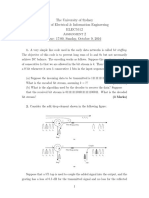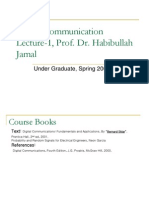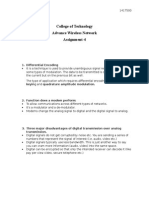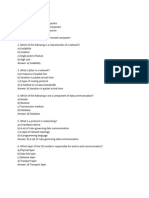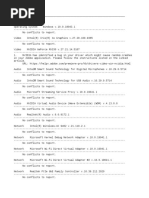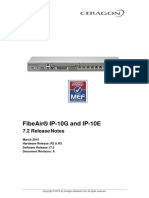Assignment 3
Uploaded by
Robert Tatenda ZataAssignment 3
Uploaded by
Robert Tatenda ZataUniversity of Zimbabwe
Faculty of Science
Department of Space Science and Applied Physics
HETT401: Optical Network Design and Transport
Assignment 3
Due Date: 2359 h 1 August 2021
1. (a) An optical fibre system is to operate at 622 Mbps over a distance of 71 km without
repeaters. A fibre with a worst case loss of 0.25 dB/km is available. The average
distance between splices is approximately 1km. There are 2 connectors and the
worst case loss per connector is 0.4 dB. The power margin is set to be at least 5 dB.
The receiver sensitivity is -28 dBm and the transmitter output is 1 dBm. Determine
the maximum allowable attenuation per fusion splice. (10 marks)
(b) What are the important mechanisms that are responsible for scattering losses in
optical fibre? (5 marks)
2. (a) Explain the components of link power budget and system rise time budget of optical
communication systems with neat sketches. (10 marks)
(b) Differentiate between LED and LD. (6 marks)
(c) Explain the fusion splicing method with a neat sketch. (4 marks)
3. (b) Write short notes on the different types of receiver noise in a fibre optic system. (5 marks)
(b) A 1550 nm SM digital fibre optical link needs to operate at 565 Mbps over 50 km
without repeaters. A single mode InGaAsp laser diode launched an average power
of -13 dBm into the fibre. The fibre has a loss of 0.35 dB/km and there is a splice
loss of 0.1 dB every km. The coupling loss at the receiver is 0.5 dB and receiver
uses InGaAs APD with sensitivity -39 dBm. Excess penalty noises are predicted to
be 1.5 dB. Set up the power budget link and system margin. (10 marks)
4. Liquid Telecommunications has established customers in Bindura who are in need of
broadband services. The customers are Barclays Bank, Econet Wireless, Bindura
University, Standard Chartered Bank, Bindura Municipality and surrounding mines.
Deploy a robust network linking the Liquid fibre ring in Norton to its intended clients in
Bindura. Requirements should be tailor made to suit each client, ensuring each client is
interconnected to its branches.
Produce a document, outlining your solution for the Fibre Optic Communication Network.
Tasks to Consider when Executing Your Project
a) Draw a network design layout.
b) What is the estimated cost of establishing your network? Justify this cost.
c) What procedures will you undertake to ensure the network is established, functional
and fulfilling clients’ needs?
d) Which equipment and tools would you use for this deployment project? And why?
e) Providing estimate figures, calculate the network capacity.
f) As a network access provider, how will you ensure that your network is optimally
functional and fully satisfying the needs its market during its lifetime?
g) If more clients emerged in Bindura and surrounding areas, how would you interlink
them to your pre-existing network?
h) Downtime occurs in networks. As a network access provider, how would you
manage this? (50 marks)
You might also like
- Installing Domino Servers and Notes ClientsNo ratings yetInstalling Domino Servers and Notes Clients271 pages
- Design and Implementation of Early-Late Gate Bit Synchronizer For Satellite CommunicationNo ratings yetDesign and Implementation of Early-Late Gate Bit Synchronizer For Satellite Communication4 pages
- Solution 2013 Final Exam (1) : Q.1 (A) The Number of Modes in An Optical Fiber, Having Core and CladdingNo ratings yetSolution 2013 Final Exam (1) : Q.1 (A) The Number of Modes in An Optical Fiber, Having Core and Cladding7 pages
- Digital Communications Questions and Answers PDF FreeNo ratings yetDigital Communications Questions and Answers PDF Free2 pages
- Optical Communication Past Questions and SolutionsNo ratings yetOptical Communication Past Questions and Solutions25 pages
- Experiment No. (8) Wavelength Division Multiplexing (WDM) : Object100% (2)Experiment No. (8) Wavelength Division Multiplexing (WDM) : Object7 pages
- Experiment No. (2) Optical Sources: ObjectNo ratings yetExperiment No. (2) Optical Sources: Object4 pages
- Lecture: Erbium Doped Fiber Amplifiers (Edfa)No ratings yetLecture: Erbium Doped Fiber Amplifiers (Edfa)11 pages
- Information Theory and Coding SEE QP 2021-22No ratings yetInformation Theory and Coding SEE QP 2021-227 pages
- Optical Fiber Communication Tutorials Senior0% (1)Optical Fiber Communication Tutorials Senior7 pages
- Bandwidth Enhancement of Microstrip Patch AntennaNo ratings yetBandwidth Enhancement of Microstrip Patch Antenna5 pages
- Experiment No.1 Rectangular Waveguide Design Using CST Microwave Studio Suite100% (2)Experiment No.1 Rectangular Waveguide Design Using CST Microwave Studio Suite3 pages
- Microwave Filters for Communication Systems: Fundamentals, Design, and ApplicationsFrom EverandMicrowave Filters for Communication Systems: Fundamentals, Design, and ApplicationsNo ratings yet
- Silica Optical Fiber Technology for Devices and Components: Design, Fabrication, and International StandardsFrom EverandSilica Optical Fiber Technology for Devices and Components: Design, Fabrication, and International StandardsNo ratings yet
- Optical and Microwave Technologies for Telecommunication NetworksFrom EverandOptical and Microwave Technologies for Telecommunication NetworksNo ratings yet
- Design and Fiber Installation For University Campus SystemNo ratings yetDesign and Fiber Installation For University Campus System7 pages
- Zimswitch Vpayments-API-and-Developer-Documentation PDFNo ratings yetZimswitch Vpayments-API-and-Developer-Documentation PDF16 pages
- Traffic Analysis Attacks On Tor - A SurveyNo ratings yetTraffic Analysis Attacks On Tor - A Survey7 pages
- VCU108 Evaluation Kit: Quick Start GuideNo ratings yetVCU108 Evaluation Kit: Quick Start Guide4 pages
- Data Communication #3 Computer Science Class XINo ratings yetData Communication #3 Computer Science Class XI13 pages
- H3C S5120-HI Series Switches Datasheet PDFNo ratings yetH3C S5120-HI Series Switches Datasheet PDF6 pages
- Cisco 2500 Series Wireless Controllers: Product OverviewNo ratings yetCisco 2500 Series Wireless Controllers: Product Overview6 pages
- ISE Profiling Design Guide - Cisco CommunityNo ratings yetISE Profiling Design Guide - Cisco Community213 pages
- Fibeair® Ip-10G and Ip-10E: 7.2 Release NotesNo ratings yetFibeair® Ip-10G and Ip-10E: 7.2 Release Notes55 pages
- CS601-Assignment No.1 Solution by M.junaid QaziNo ratings yetCS601-Assignment No.1 Solution by M.junaid Qazi3 pages











